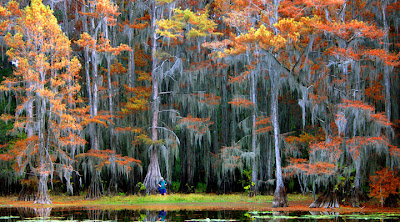Caddo Lake is a large natural lake on the border of Texas and Louisiana, site of the world's largest cypress forest. The lake itself measures 25,400 acres (10,300 hectares), and it is surrounded by a maze of bayous and swamps. It is home to alligators, eagles, herons, egrets, and so on through a list of more than 300 animal species.
Now much of this region is protected by state parks, but this was not always so. Around 1900 the Corps of Engineers cleared a shipping channel through the swamps, but the result was that the water in the lake fell by ten feet, leaving the docks that the channel was meant to serve high and dry. Then a dam was built to try to raise the water level. And so it goes.
But the lake may not be that ancient anyway. Geologists are convinced it is a recent formation, although they disagree about how it formed. One view is that it was created by the New Madrid Earthquake of 1812, which caused the land to sink. Another is that the lake was created by the "Great Raft," a huge logjam which blocked the Red River. This logjam was first carefully described in 1806, but it may have been mentioned by Spanish explorers in the 1500s; in the early 1800s it was more than a hundred miles long. This is the obstruction the Corps of Engineers was trying to clear from the Red River when they accidentally drained the lake.
Back around 1900 oil was discovered under the swamp, and in 1911 the world's first over-water oil drilling platform was erected over the lake. But it turned out that the oil was not worth the trouble, and the drillers soon moved on to other fields. In the Depression, drilling around the lake was abandoned. Then a major ammunition plant was built along the Texas shore, dumping lots of toxic junk into the lake in the 1950s and 1960s. This was shut down in the 1990s.
These days the major threat to the lake seems to be a plant, a Brazilian import known as giant salvinia (Salvinia molesta), which has so clogged some areas that the authorities have resorted to imported beetles and even mass herbicide sprays to control it.
Among the lake's many treasures is the world's largest colony of a shrub called the Mayhaw. The jelly made from these fruit is said by enthusiasts to be the best in the world.
Subscribe to:
Post Comments (Atom)











No comments:
Post a Comment